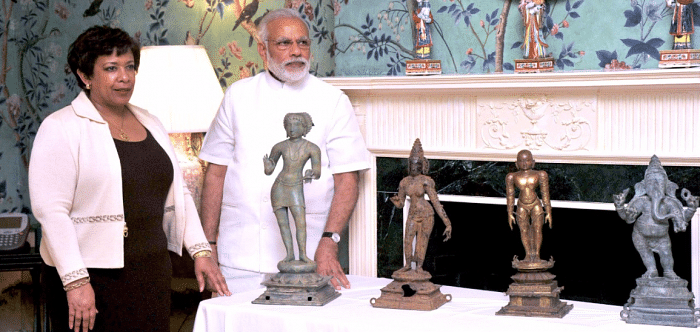Prime Minister Narendra Modi’s visits abroad often have a return gift. He has brought back more than a dozen historical artifacts from the United States, Australia, Canada, Germany and Singapore.
Since 2014, the Indian government has retrieved 24 Indian antiquities from around the world that were either stolen or smuggled out. In contrast, from 2009 to 2014, just one such object was brought back to the country, the Archaeological Survey of India (ASI) has said.
“There has been some momentum in the last 2-3 years (in bringing back Indian antiquities),” D.N. Dimri, Director (Antiquities) at the ASI, told ThePrint. He said he could not claim that the change has been spurred by the BJP coming to power but agreed that the country has made “significant gains in the recent past”.
Between 2004-09 no such objects were brought back, an official from the ASI said. In fact, between 1976 and 2013, a total of 13 antiquities had been brought back to India, she said.
Bringing back Indian artifacts and cultural heritage remains a “key element in India’s foreign policy”, a government official told ThePrint. The return of these historical objects is part of the “restoration of India’s pride and an acknowledgement of history” as well as a projection of India’s soft-power, the official said.
Over the last two years, 16 objects have been brought back from the US alone. When Prime Minister Narendra Modi visited the US in 2016, the US agreed to return 200 antiquities to India. However, a year and another visit later, only 16 of the 200 objects have been returned.
The government official said they were not aware of the exact status of the rest of the objects.
According to records updated until March from the Ministry of Culture, between 2000 and 2016 a total 101 antiquities have been stolen from Centrally Protected Monuments. However, experts estimate that the actual number of stolen objects over the years runs into several thousands. What is recovered, or even identified, remains a drop in the ocean.
“There has never been a concerted effort by the Indian government (to bring back stolen objects),” said Sudha Gopalakrishnan, former director at the National Mission of Manuscripts. She said that even the maintenance of existing antiquities, let alone stolen ones, barely meets international standards. “Antiquities are scattered all around. They don’t even have a concerted list of antiquities,” Gopalakrishnan said.
The lack of a concerted governmental effort and political apathy for decades had also prompted a handful of private citizens groups to become active.
In 2013, a group called India Pride Project began lobbying efforts to bring back lost antiquities. Its founder, Anuraag Saxena, describes the group as one of “random, mid-IQ guys working on Skype and WhatsApp on weekends”.
Saxena and his partner Vijay Kumar are both Singapore-based NRIs, and he says they were frequently incensed to see Indian heritage scattered in other parts of the world. “It is bureaucratic failure that creates us activists,” Saxena said.
With a core team of 11 members with independent jobs of their own, and volunteers around the world, Saxena says his group coordinates with the government, international agencies, museums and a small, tightly-knit global curator community to investigate cases of missing antiquities. He speaks of secret investigations, back-channel negotiations and encrypted communication, but hesitates when it comes to divulging the level of engagement with the government.
Gopalakrishnan, who claims to have “heard of the group”, says that it is indeed “perplexing” how the group carries out its activities. “It is laudable if they have found a foolproof way (of identifying and tracing stolen antiquities), but I’m not sure how feasible it is,” she said.
Dimri echoes Gopalakrishnan’s scepticism. “Till date, we have not received any authentic information from this group. We don’t know who they have been giving information to,” he said.
Of the five cases the group claims to have solved, one involved conducting the investigation for bringing back the 11th century Chola statue of a dancing Shiva from Australia, which was handed over to Modi by his Australian counterpart Tony Abbott in 2014. The group’s website also lists its work toward the repatriation Sripuranthan Nataraja, Sandstone Yakshi, Bronze Ganesha and Uma Parameshwari.
The website, in fact, states: “The Mughals plundered us. Then the colonials. It’s time to get our Gods back home.”
A historical art curator, who spoke to ThePrint on the condition of anonymity, said that the group is ideologically driven and only investigates Hindu-antiquities. He also said that outsourcing the task of recovering lost heritage to non-governmental organisations or private individuals is fraught with risks:
“(As a private individual) I will always bring back what suits my version of history,” he said.
